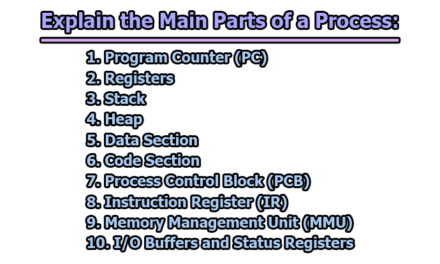Basic Understanding of CPU Scheduling Algorithms:
To ensure timely completion of tasks, procedures and work assignments are carefully scheduled. Through the use of scheduling techniques, computers can optimize CPU utilization by prioritizing one process over another, while some processes may be temporarily paused or delayed due to resource constraints such as I/O availability. The primary objective of CPU scheduling is to enhance system speed, fairness, and efficiency, thereby maximizing overall performance. In the rest of this article, we will explore the basic understanding of CPU scheduling algorithms.
What is CPU Scheduling?
CPU scheduling is a dynamic process aimed at optimizing CPU utilization within a computer system. It facilitates the execution of multiple processes concurrently, ensuring that the CPU operates at its maximum potential. By prioritizing and orchestrating processes, CPU scheduling minimizes idle CPU time, thereby improving system efficiency and speed.
The scheduling mechanism involves maintaining queues of processes in different states and selecting the most appropriate process for execution based on specific criteria. This ensures that the CPU remains engaged in productive tasks, minimizing waiting times and idle cycles.
Understanding Waiting Time in CPU:
Waiting time refers to the duration a process spends in a ready state, eagerly awaiting its turn to execute on the CPU. It’s a decisive metric that directly influences system efficiency, responsiveness, and overall performance.
1. The Discrepancy in CPU-Memory Speed: One of the primary reasons for waiting time in CPU scheduling stems from the inherent speed discrepancy between the CPU and memory. Modern CPUs are incredibly fast and can execute instructions at lightning speed. However, fetching data from memory is comparatively slower, leading to a significant gap in processing speeds. This dichotomy creates idle CPU time during data retrieval operations, as the CPU must wait for the necessary data to be fetched from memory before proceeding with execution.
2. Impact on System Efficiency: The waiting time experienced by processes in the ready queue directly impacts system efficiency and resource utilization. Long waiting times and idle CPU cycles diminish system efficiency, making processes time-consuming and potentially leading to underutilization of available resources. Inefficient CPU scheduling can result in poor system responsiveness, sluggish performance, and overall degradation of user experience.
3. Scheduling as a Solution: To mitigate the negative impact of waiting time on system efficiency, scheduling systems are employed. These systems manage process queues and prioritize task execution, enabling the CPU to remain engaged in productive tasks while others are waiting for input/output operations to complete. By efficiently allocating CPU time to processes, scheduling systems prevent the wastage of CPU cycles and ensure optimal resource utilization.
4. Preventing Loss of CPU Cycles: One of the primary objectives of CPU scheduling is to prevent the loss of CPU cycles due to idle time or inefficient resource allocation. By intelligently prioritizing processes and managing process queues, scheduling algorithms aim to keep the CPU busy and maximize its utilization. This not only enhances system efficiency but also contributes to faster task completion and improved overall performance.
5. Challenges in Dynamic Conditions: Operating efficiently in dynamic conditions poses significant challenges for CPU scheduling algorithms. Fluctuations in workload, varying resource demands, and changing system priorities require adaptive scheduling strategies to maintain fairness, efficiency, and responsiveness. Schedulers must dynamically adjust process priorities and resource allocations to meet evolving system requirements and ensure optimal performance under varying workloads.
6. Task Prioritization: Task prioritization is a fundamental aspect of efficient CPU process execution, ensuring that critical tasks receive prompt attention and resources. By assigning priorities to different tasks, the CPU scheduler can effectively manage the allocation of CPU time, ensuring that high-priority tasks are executed without delay. This prioritization strategy helps optimize system performance by focusing resources on tasks that are most critical or time-sensitive. Without proper task prioritization, the CPU may allocate resources inefficiently, leading to delays in critical operations and potentially impacting overall system responsiveness. Therefore, prioritizing tasks appropriately is essential for maximizing system efficiency and ensuring smooth operation under varying workload conditions.
Consequently, enhancing system efficiency poses a significant challenge. Systems must operate equitably and effectively, which becomes particularly challenging in dynamic conditions. Moreover, prioritizing tasks is a critical factor that must be taken into account when executing processes on the CPU.
Queues Involved in Scheduling:
There are three types of queues which are involved with the CPU usage are:
- Job Queue: The job queue serves as the entry point for processes awaiting execution by the CPU. It contains all processes submitted to the system, either from users or from other system components. Processes in the job queue may vary in their arrival times, priorities, and resource requirements. The job queue is managed by the long-term scheduler, which selects processes from this queue and allocates them to the system’s resources based on various criteria, such as system load and resource availability.
- Ready Queue: The ready queue comprises processes that are currently residing in main memory and are ready for execution. These processes have already been loaded into memory and are awaiting their turn to be executed by the CPU. Processes in the ready queue are in a state of readiness, waiting for the CPU scheduler to select them for execution. The ready queue is managed by the CPU scheduler, also known as the short-term scheduler. It is responsible for selecting the most suitable process from the ready queue and allocating CPU time to it based on scheduling algorithms and policies.
- Device Queue: The device queue, also known as the I/O queue, contains processes that are waiting for input/output (I/O) operations to be completed. When a process initiates an I/O operation, such as reading from or writing to a disk or network interface, it relinquishes control of the CPU and enters the device queue associated with the specific I/O device. Processes in the device queue remain suspended until the I/O operation is completed, at which point they are transferred back to the ready queue for CPU execution. Multiple processes may be waiting in the device queue for the same I/O device, and the completion of one I/O operation may trigger the execution of another process waiting in the ready queue.
These queues are managed by different scheduling algorithms to ensure efficient process execution and resource utilization.
Components of CPU Scheduling:
The scheduling process is done with the help of CPU Burst Cycle, Dispatcher and the scheduler.
The CPU Burst Cycle is a fundamental concept in CPU scheduling, representing the alternating periods of CPU execution and I/O operations within a process. Each process undergoes a series of CPU bursts, during which it actively utilizes the CPU for computation, interspersed with I/O bursts, where it awaits data transfer to or from external devices. The duration of the CPU burst cycle varies depending on the nature of the process and its resource requirements.
The Scheduler is a key component responsible for selecting processes from the ready queue for execution on the CPU. When the processor becomes idle, the scheduler identifies the next process to run based on predefined criteria such as process priority, execution time, or scheduling algorithm. The scheduler considers both the storage structure of the ready queue and the scheduling algorithm to determine the most suitable process for execution. By prioritizing processes effectively, the scheduler aims to optimize system performance and resource utilization.
The Dispatcher is another essential component involved in CPU scheduling, responsible for facilitating the transition of processes from the ready state to the running state on the CPU. Once the scheduler selects a process for execution, the dispatcher takes over and performs the following tasks:
- Switching of Processes: The dispatcher switches the CPU from executing the current process to the selected process, initiating the context switch.
- Switching User Mode: The dispatcher switches the CPU to user mode, allowing the selected process to execute in user space without direct access to system resources.
- Setting Processor State: The dispatcher ensures that the processor reaches the appropriate location in the user program, continuing execution from where the process left off previously.
The dispatcher operates at a rapid pace to manage process switches efficiently, minimizing the delay between context switches. The time required by the dispatcher to terminate one process and switch to another is known as dispatch latency. Minimizing dispatch latency is crucial for maintaining system responsiveness and ensuring smooth process execution.
CPU scheduling occurs in various instances, including transitions between different process states such as running to ready, waiting to ready, and running to waiting. These transitions occur dynamically as processes interact with the system and require efficient scheduling to ensure optimal resource utilization and responsiveness.
Terminologies of CPU Scheduling Algorithms:
1. Arrival Time: Arrival time refers to the instant when a process enters the ready queue and becomes available for execution on the CPU. Each process has its own arrival time, which may vary depending on factors such as user input, system requests, or inter-process communication.
2. Completion Time: Completion time denotes the moment when a process finishes its execution on the CPU and exits the system. It represents the total duration from the process’s arrival in the ready queue to its completion, including both CPU execution time and any waiting or I/O processing time.
3. Burst Time: Burst time, also known as execution time or CPU time, quantifies the duration required by a process to execute its instructions on the CPU without interruption. It encompasses the time spent actively utilizing the CPU for computation or processing tasks and excludes any periods of waiting for I/O operations or other resources.
4. Turnaround Time: Turnaround time measures the total elapsed time for a process to complete its execution from the moment of its arrival in the ready queue. It includes both the CPU execution time and any waiting or I/O processing time experienced by the process. Turnaround time reflects the overall responsiveness and efficiency of the CPU scheduling algorithm.
5. Waiting Time: Waiting time represents the cumulative duration that a process spends in the ready queue, awaiting its turn for CPU execution. It encompasses the time interval between a process’s arrival in the ready queue and the initiation of its CPU execution. Minimizing waiting time is a key objective of CPU scheduling algorithms to enhance system responsiveness and resource utilization.
6. Load Average: Load average measures the average number of processes residing in the ready queue and waiting for CPU execution over a specified time interval. It provides insights into the system’s workload and resource demand, enabling administrators to gauge system performance and make informed decisions about resource allocation and scheduling policies.
7. Response Time: Response time refers to the duration elapsed from the submission of a request or task to the system until the first response or output is produced. In the context of CPU scheduling algorithms, response time signifies the time taken by the CPU to initiate the execution of a process after it enters the ready queue. Minimizing response time is crucial for ensuring prompt system responsiveness and user satisfaction.
Goals of CPU Scheduling Algorithms:
CPU scheduling algorithms aim to achieve several overarching goals to optimize system performance and resource utilization:
1. Maximize CPU Utilization: The primary goal is to keep the CPU busy and maximize its utilization by executing processes efficiently. Minimizing idle CPU time ensures that computing resources are utilized effectively, enhancing system throughput and performance.
2. Equitable CPU Allocation: CPU scheduling algorithms strive to allocate CPU time fairly among competing processes, ensuring that no process monopolizes CPU resources at the expense of others. Equitable CPU allocation promotes fairness and prevents starvation, where low-priority processes are indefinitely delayed.
3. Maximize Throughput: CPU scheduling algorithms aim to maximize the number of processes completed or serviced within a given time interval, known as throughput. Increasing throughput enhances system efficiency and productivity, enabling more tasks to be executed in a shorter duration.
4. Minimize Turnaround Time: Minimizing turnaround time, the duration from process arrival to completion, is a key objective of CPU scheduling algorithms. Reduced turnaround time improves system responsiveness and user satisfaction by expediting the execution of processes and minimizing waiting times.
5. Minimize Waiting Time: CPU scheduling algorithms strive to minimize waiting time, the time processes spend in the ready queue awaiting CPU execution. By reducing waiting time, algorithms enhance system responsiveness, optimize resource utilization, and improve overall performance.
6. Minimize Response Time: Minimizing response time, the time taken to initiate process execution after arrival, is crucial for ensuring prompt system responsiveness and user interaction. Fast response times enhance user experience and efficiency, particularly in interactive and real-time computing environments.
Different Types of CPU Scheduling Algorithms:
CPU scheduling algorithms are essential components of operating systems responsible for managing the execution of processes on the CPU. These algorithms employ various strategies to allocate CPU time among competing processes efficiently. Understanding the different types of CPU scheduling algorithms is crucial for optimizing system performance and resource utilization. Below are some of the commonly used types of CPU scheduling algorithms:
1. First Come First Serve (FCFS): In the First Come First Serve (FCFS) scheduling algorithm, processes are executed in the order of their arrival in the ready queue. The process that enters the ready queue first is selected for execution by the CPU. FCFS operates on the principle of a queue data structure, where new processes are added to the tail of the queue and selected for execution from the head.
Advantages:
- Simple to understand and implement.
- Ensures fairness as processes are executed in the order of their arrival.
Disadvantages:
- Non-preemptive nature may lead to longer waiting times for high-priority processes.
- Does not prioritize processes based on their execution time or resource requirements.
- May result in poor resource utilization and the convoy effect, where long processes hold up short processes.
2. Shortest Job First (SJF): The Shortest Job First (SJF) scheduling algorithm prioritizes processes with the shortest burst time or execution time. It aims to minimize waiting times by executing shorter processes before longer ones. SJF can be implemented in both non-preemptive and preemptive modes.
Advantages:
- Minimizes waiting times and turnaround times for processes.
- Optimizes resource utilization by prioritizing short processes.
- Suitable for environments with predictable process execution times.
Disadvantages:
- Requires knowledge of process burst times, which may not always be available.
- May lead to starvation of longer processes if shorter processes continuously arrive.
- Preemptive SJF introduces overhead due to frequent context switches.
3. Priority Scheduling: Priority scheduling assigns priorities to processes based on factors such as process importance, resource requirements, or user-defined criteria. Higher-priority processes are executed before lower-priority ones, regardless of arrival order. Priority scheduling can be preemptive or non-preemptive, depending on whether the priorities can be changed dynamically during execution.
Advantages:
- Allows for prioritization of critical processes, ensuring timely execution.
- Flexible and customizable based on system requirements and user preferences.
- Can adapt to changing workload and resource demands.
Disadvantages:
- Risk of priority inversion, where lower-priority processes block higher-priority ones.
- Potential for starvation if high-priority processes monopolize CPU time.
- Requires careful management of priorities to avoid system instability.
4. Round Robin Scheduling: Round Robin (RR) scheduling allocates a fixed time slice, known as a quantum, to each process in the ready queue. Processes are executed in a cyclic manner, with each process given a turn to run for the duration of one quantum. If a process does not complete within its quantum, it is preempted, and the CPU is allocated to the next process in the queue.
Advantages:
- Provides fairness by ensuring equal CPU time for all processes.
- Prevents starvation by enforcing a maximum wait time for each process.
- Suitable for time-sharing systems and interactive environments.
Disadvantages:
- May introduce overhead due to frequent context switches, especially with small quantum sizes.
- May lead to inefficient CPU utilization if processes have vastly different execution times.
- Performance depends on the choice of quantum size, which must balance fairness and efficiency.
5. Multilevel Queue Scheduling: Multilevel queue scheduling divides the ready queue into multiple priority levels or queues, each with its own scheduling algorithm. Processes are assigned to different queues based on criteria such as priority, process type, or resource requirements. Each queue may have its own scheduling policy, allowing for efficient management of diverse workloads.
Advantages:
- Allows for differentiation of processes based on priority or other attributes.
- Ensures that high-priority processes receive preferential treatment.
- Facilitates resource allocation and management for different types of processes.
Disadvantages:
- Complexity increases with the number of queues and scheduling policies.
- Risk of priority inversion or starvation if not carefully managed.
- Requires careful tuning of queue parameters and policies for optimal performance.
6. Multilevel Feedback Queue Scheduling: Multilevel feedback queue scheduling is an extension of multilevel queue scheduling that allows processes to move between different queues based on their behavior. Processes may start in a high-priority queue and move to lower-priority queues if they use too much CPU time or vice versa. This dynamic adjustment helps balance system responsiveness and resource utilization.
Advantages:
- Adapts to changing workload and process behavior.
- Prevents starvation by allowing processes to move between queues.
- Provides flexibility in resource allocation and scheduling.
Disadvantages:
- Increased complexity compared to traditional scheduling algorithms.
- Risk of performance degradation if queue parameters are not properly configured.
- Requires careful tuning and monitoring to ensure optimal performance.
In conclusion, in the ever-evolving landscape of computing, CPU scheduling plays a pivotal role in optimizing system performance and resource utilization. By implementing efficient scheduling algorithms and strategies, computer systems can achieve higher throughput, reduced response times, and enhanced overall efficiency. As technology continues to advance, further innovations in CPU scheduling will undoubtedly shape the future of computing, ensuring seamless operation and productivity in diverse environments.

Assistant Teacher at Zinzira Pir Mohammad Pilot School and College










